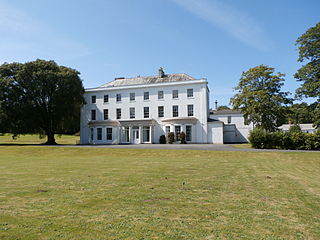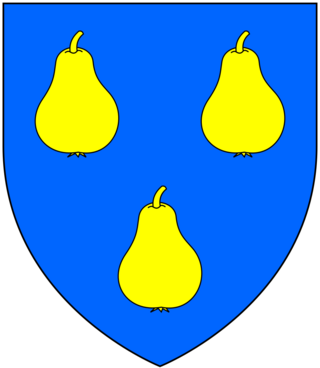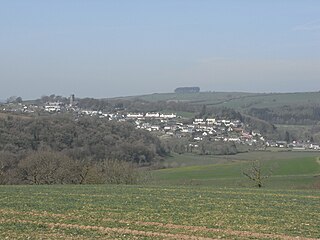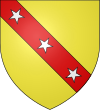
Baron Poltimore, of Poltimore in the County of Devon, is a title in the Peerage of the United Kingdom. It was created in 1831 for Sir George Bampfylde, 6th Baronet. His son, the second Baron, held office as Treasurer of the Household from 1872 to 1874 in the first Liberal administration of William Ewart Gladstone.

John Bampfylde of Hestercombe in Somerset, was an English landowner and politician who sat in the House of Commons between 1715 and 1741.

Tamerton Foliot is a village and former civil parish situated in the north of Plymouth, in the Plymouth district, in the ceremonial county of Devon, England. It also lends its name to the ecclesiastical parish of the same name.

Colonel Sir Frederick Winn Knight was an English Conservative politician who sat in the House of Commons from 1841 to 1885.

Moreton House is a grade II listed country house and former large estate near Bideford, North Devon, England. The house is about one mile west of the old centre of Bideford town, its entrance drive leading off the south side of the road between Bideford and the village of Abbotsham. It has in recent years become increasingly surrounded by the suburbs of Bideford, and in 2014 only 5 acres of the former parkland remain attached to the house. The estate is said anciently to have been the property of the famous Grenville family, lords of the Manor of Bideford, and of Stowe, Kilkhampton in Cornwall. It was later acquired by the Buck merchant family of Bideford, which rebuilt the house in 1760 and again in 1821.

Sir Coplestone Warwick Bampfylde, 3rd Baronet of Poltimore and North Molton, Devon, was a British landowner and High Tory politician who sat in the House of Commons from 1710 to 1727.

Sir Richard Warwick Bampfylde, 4th Baronet of Poltimore, North Molton, Warleigh, Tamerton Foliot and Copplestone in Devon and of Hardington in Somerset, England, was Member of Parliament for Exeter (1743–47) and for Devonshire (1747–76).

The Stucley Baronetcy, of Affeton Castle in the County of Devon, is a title in the Baronetage of the United Kingdom. It was created on 26 April 1859 for George Stucley, Conservative Member of Parliament for Barnstaple from 1855 to 1857. Born George Stucley Buck, he had assumed by Royal licence the surname of Stucley in lieu of his patronymic, on the death of his father, in 1858 as lineal representative of the ancient Stucley family. This family, which possessed Affeton Castle in Devon for over 600 years, originally came from the village of Stukeley in Huntingdonshire, and were sheriffs of that county during the reign of King John. The family are descended from Richard Stucley, of Trent, Somerset, and Elizabeth Fitzroger his wife. Their son, Hugh Stucley married Katherine Affeton, heiress of the Affeton estates, and was sheriff of Devon in 1448. The fifth Baronet served as a Deputy Lieutenant and High Sheriff of Devon.
Augustus Frederick George Warwick Bampfylde, 2nd Baron Poltimore, styled The Honourable Augustus Bampfylde until 1858, of Poltimore House and North Molton in Devon, was a British Liberal politician. Between 1872 and 1874 he served as Treasurer of the Household to Queen Victoria, under William Ewart Gladstone.

Sir Charles Warwick Bampfylde, 5th Baronet of Poltimore in Devon, was a British politician who served twice as Member of Parliament for Exeter, in 1774–1790 and 1796–1812.

Sir Coplestone Bampfylde, 2nd Bt., DL, JP of Poltimore and North Molton and Warleigh, Tamerton Foliot, in Devon, was an English politician who sat in the House of Commons at various times between 1659 and 1689.

Sir John Bampfylde, 1st Baronet of Poltimore and North Molton and Tamerton Foliot, all in Devon, was an English lawyer and politician. He was one of Devonshire's Parliamentarian leaders during the Civil War.

North Molton is a village, parish and former manor in North Devon, England. The population of the parish in 2001 was 1,047, decreasing to 721 in the 2011 census. An electoral ward with the same name also exists. The ward population at the census was 2,206. Bounded on the north east by the border with Somerset, it is the second largest parish in Devon, covering about 15,000 acres. Until the 18th century the village was an important centre of the woollen industry, and mining was also a significant employer in the parish until the 19th century.

John Bampfield of Poltimore House and North Molton, Devon, England, was a Member of Parliament for Tiverton in Devon (1621) and for the prestigious county seat of Devon (1628-9).

Sir Amyas Bampfylde of Poltimore and North Molton in Devon, England, was a Member of Parliament for Devon in 1597.

The Manor of Poltimore is a former manor in Devon, England. The manor house known as Poltimore House survives in its 18th-century remodelled form, but has been dilapidated for several decades. A charity named the "Poltimore House Trust" has been established for the purpose of its restoration. The manor was situated within the historic Wonford Hundred and was largely coterminous with the parish of Poltimore and contained the village of Poltimore, 4 miles (6.4 km) north-east of the historic centre of the City of Exeter. It should not be confused with the eponymous Devon estate of Poltimore in the parish of Farway, 16 miles (26 km) east of Exeter. Poltimore was the principal seat of the Bampfylde family from c. 1300 to 1920.

Warleigh is a historic estate within the parish of Bickleigh in Devon, about 6 miles from Plymouth. Warleigh House, the manor house of the manor of Tamerton Foliot is situated one mile west of that village on the south-east bank of the River Tavy where it joins the River Tamar. It was remodelled in about 1830 in the Gothic style by John Foulston and has been listed Grade II* on the National Heritage List for England since 1960.

Sir Hugh Stucley (1496–1559) was the lord of Affeton in Devon, and Sheriff of Devon in 1545. His third son was Thomas Stukley, known as "The Lusty Stucley".

John Knight (1765–1850) of Lea Castle, Wolverley, of 52 Portland Place in London, and of Simonsbath House, Exmoor, Somerset, was an agricultural pioneer who commenced the reclamation of the barren moorland of the former royal forest of Exmoor in Devon and Somerset, England.
Christine Elizabeth Lytton Cobbold, Baroness Cobbold, was a British aristocrat and writer. She was married to David Lytton Cobbold, 2nd Baron Cobbold; together they organised the Knebworth Festival at Knebworth House.














